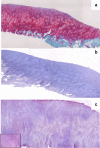One-step surgery with multipotent stem cells and Hyaluronan-based scaffold for the treatment of full-thickness chondral defects of the knee in patients older than 45 years
- PMID: 26768608
- PMCID: PMC5548854
- DOI: 10.1007/s00167-016-3984-6
One-step surgery with multipotent stem cells and Hyaluronan-based scaffold for the treatment of full-thickness chondral defects of the knee in patients older than 45 years
Erratum in
-
Erratum to: One-step surgery with multipotent stem cells and Hyaluronan-based scaffold for the treatment of full-thickness chondral defects of the knee in patients older than 45 years.Knee Surg Sports Traumatol Arthrosc. 2018 Jul;26(7):2217. doi: 10.1007/s00167-017-4698-0. Knee Surg Sports Traumatol Arthrosc. 2018. PMID: 28894878 Free PMC article. No abstract available.
Abstract
Purpose: The aim of this study is to prospectively evaluate the medium-term effectiveness and regenerative capability of autologous adult mesenchymal stem cells, harvested as bone marrow aspirate concentrate (BMAC), along with a hyaluronan-based scaffold (Hyalofast) in the treatment of ICRS grade 4 chondral lesions of the knee joint, in patients older than 45 years.
Methods: A study group of 20 patients with an age >45 years (mean 50.0 ± 4.1 years) was compared to a control group of 20 patients with an age <45 years (mean 36.6 ± 5.0). Patients were prospectively evaluated for 4 years. All patients were evaluated with MRI, KOOS, IKDC, VAS and Tegner scores preoperatively and at two-year and final follow-up.
Results: At final follow-up, all scores significantly improved (P < 0.001) as follows: all KOOS score categories; Tegner 2 (range 0-4) to 6 (range 4-8) and 3 (range 0-6) to 6 (range 3-10); IKDC subjective (39.2 ± 16.5 to 82.2 ± 8.9) and (40.8 ± 13.9 to 79.4 ± 14.6), in the study and control group respectively. In addition, we show that results are affected by lesion size and number but not from concomitant surgical procedures. MRI showed complete filling in 80 % of patients in the study group and 71 % of patients in the control group. Histological analysis conducted in three patients from the study and two patients from the control group revealed good tissue repair with a variable amount of hyaline-like tissue.
Conclusion: Treatment of cartilage lesions with BMAC and Hyalofast is a viable and effective option that is mainly affected by lesion size and number and not by age. In particular, it allows to address the >45 years population with functional outcomes that are comparable to younger patients at final follow-up.
Level of evidence: Prospective cohort study, Level II.
Keywords: Bone Marrow Aspirate Concentrate (BMAC); Cartilage; Cartilage lesion; Hyaluronan; Mesenchymal Stem cells (MSCs); Scaffold.
Conflict of interest statement
Dr. Gobbi is Scientific Consultant for Anika Therapeutics Inc. Massachusetts, USA.
Figures



Similar articles
-
Long-term Clinical Outcomes of One-Stage Cartilage Repair in the Knee With Hyaluronic Acid-Based Scaffold Embedded With Mesenchymal Stem Cells Sourced From Bone Marrow Aspirate Concentrate.Am J Sports Med. 2019 Jun;47(7):1621-1628. doi: 10.1177/0363546519845362. Epub 2019 May 16. Am J Sports Med. 2019. PMID: 31095402
-
One-step surgery with multipotent stem cells for the treatment of large full-thickness chondral defects of the knee.Am J Sports Med. 2014 Mar;42(3):648-57. doi: 10.1177/0363546513518007. Epub 2014 Jan 23. Am J Sports Med. 2014. PMID: 24458240
-
One-Stage Cartilage Repair Using a Hyaluronic Acid-Based Scaffold With Activated Bone Marrow-Derived Mesenchymal Stem Cells Compared With Microfracture: Five-Year Follow-up.Am J Sports Med. 2016 Nov;44(11):2846-2854. doi: 10.1177/0363546516656179. Epub 2016 Jul 29. Am J Sports Med. 2016. PMID: 27474386
-
The Role of Bone Marrow Aspirate Concentrate for the Treatment of Focal Chondral Lesions of the Knee: A Systematic Review and Critical Analysis of Animal and Clinical Studies.Arthroscopy. 2019 Jun;35(6):1860-1877. doi: 10.1016/j.arthro.2018.11.073. Epub 2019 Mar 11. Arthroscopy. 2019. PMID: 30871903
-
Autologous tissue transplantations for osteochondral repair.Dan Med J. 2016 Apr;63(4):B5236. Dan Med J. 2016. PMID: 27034191 Review.
Cited by
-
Algorithm for Treatment of Focal Cartilage Defects of the Knee: Classic and New Procedures.Cartilage. 2021 Dec;13(1_suppl):473S-495S. doi: 10.1177/1947603521993219. Epub 2021 Mar 20. Cartilage. 2021. PMID: 33745340 Free PMC article. Review.
-
PRP and BMAC for Musculoskeletal Conditions via Biomaterial Carriers.Int J Mol Sci. 2019 Oct 25;20(21):5328. doi: 10.3390/ijms20215328. Int J Mol Sci. 2019. PMID: 31717698 Free PMC article. Review.
-
Cheilectomy, Osteotomy, Microfracture, and Matrix-Induced Chondrogenesis (COMM): A Novel Combined Procedure for Treating Hallux Rigidus.Cartilage. 2025 May 22:19476035251325094. doi: 10.1177/19476035251325094. Online ahead of print. Cartilage. 2025. PMID: 40401530 Free PMC article.
-
Mesenchymal stem cells augmentation for surgical procedures in patients with symptomatic chondral defects of the knee: a systematic review.J Orthop Surg Res. 2022 Sep 14;17(1):415. doi: 10.1186/s13018-022-03311-1. J Orthop Surg Res. 2022. PMID: 36104803 Free PMC article.
-
Use of polyglycolic acid-hyaluronic acid/β-tricalcium phosphate scaffold with or without mesenchymal stem cells found ineffective in treating osteochondral lesions in rabbit knees.Acta Orthop Traumatol Turc. 2023 Sep;57(5):209-214. doi: 10.5152/j.aott.2023.23054. Acta Orthop Traumatol Turc. 2023. PMID: 37828858 Free PMC article.
References
-
- Battaglia M, Rimondi E, Monti C, Guaraldi F, Sant’Andrea A, Buda R, Cavallo M, Giannini S, Vannini F. Validity of T2 mapping in characterization of the regeneration tissue by bone marrow derived cell transplantation in osteochondral lesions of the ankle. Eur J Radiol. 2011;80(2):e132–e139. doi: 10.1016/j.ejrad.2010.08.008. - DOI - PubMed
-
- Cavallo C, Desando G, Columbaro M, Ferrari A, Zini N, Facchini A, Grigolo B. Chondrogenic differentiation of bone marrow concentrate grown onto a hyaluronan scaffold: rationale for its use in the treatment of cartilage lesions. J Biomed Mater Res A. 2013;101(6):1559–1570. doi: 10.1002/jbm.a.34460. - DOI - PubMed
MeSH terms
Substances
LinkOut - more resources
Full Text Sources
Other Literature Sources
Medical
Research Materials

